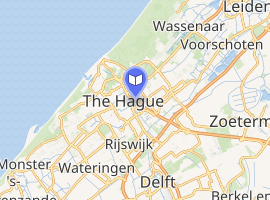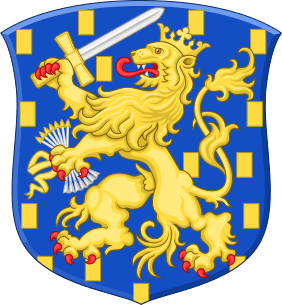Royal Library of the Netherlands
The Royal Library of the Netherlands (Dutch: Koninklijke Bibliotheek or KB; Royal Library) is the national library of the Netherlands, based in The Hague, founded in 1798.[2][3] The KB collects everything that is published in and concerning the Netherlands, from medieval literature to today's publications. About 7 million publications are stored in the stockrooms, including books, newspapers, magazines and maps. The KB also offers many digital services, such as the national online Library (with e-books and audiobooks), Delpher (millions of digitized pages) and The Memory. Since 2015, the KB has played a coordinating role for the network of the public library.[4]
| Koninklijke Bibliotheek (KB) | |
 | |
.jpg) The KB as seen from the Prins Bernhardviaduct | |
| Type | National Library |
|---|---|
| Established | 1798 |
| Location | The Hague |
| Coordinates | 52°4′50.37″N 4°19′36.35″E |
| Collection | |
| Size | 7 million printed items: over 115 km (71 miles) of books, newspapers, journals, and microforms[1] |
| Access and use | |
| Members | 16,975 |
| Other information | |
| Budget | €53 million |
| Director | Lily Knibbeler |
| Staff | 412 |
| Website | www |
| Map | |

| |
History
The initiative to found a national library was proposed by representative Albert Jan Verbeek on August 17, 1798. The collection would be based on the confiscated book collection of William V.[5][6] The library was officially founded as the Nationale Bibliotheek on November 8 of the same year, after a committee of representatives had advised the creation of a national library on the same day. The National Library was initially only open to members of the Representative Body.
King Louis Bonaparte gave the national library its name of the Royal Library in 1806. Napoleon Bonaparte transferred the Royal Library to The Hague as property, while also allowing the Imperial Library in Paris to expropriate publications from the Royal Library. In 1815 King William I of the Netherlands confirmed the name of 'Royal Library' (Dutch: Koninklijke Bibliotheek) by royal resolution. It has been known as the National Library of the Netherlands since 1982, when it opened new quarters.[7] The institution became 'Independent Administrative Body' of the state in 1996, although it is financed by the Department of Education, Culture and Science. On 18 November 2014 the Wsob (Public Library Facilities System Act or 'Library Act') came into being. The act became valid on 1 January 2015 and from this moment onwards four organizations from the library world continued under the name Koninklijke Bibliotheek. These organizations are Sector Institute Public Libraries (SIOB), the Foundation Bibliotheek.nl (BNL), the Digital Library for Dutch Literature (DBNL) and the Koninklijke Bibliotheek (KB).
Collection
The humanities are central to the collection of the KB, with an emphasis on Dutch history, language and culture.
In 2016, the KB contained 7,000,000 items, equivalent to 115 kilometers of bookshelves. Most items in the collection are books. There are also pieces of "grey literature", where the author, publisher, or date may not be apparent but the document has cultural or intellectual significance.[7] The collection contains almost the entire literature of the Netherlands, from medieval manuscripts to modern scientific publications. As there was no law for depositing Dutch publication the library started on January 1 1974 the voluntary Dutch Repository Library. This in contrast with most other countries that have a legal deposit of publications. For a publication to be accepted, it must be from a registered Dutch publisher.[7]
The collection is accessible for members. Any person aged 16 years or older can become a member. One day passes are also available. Requests for material take approximately 30 minutes. The KB hosts several open access websites, including the "Memory of the Netherlands" (Geheugen van Nederland),[8] Digital Library for Dutch Literature[9] and Delpher, an archive of more than 100 million pages as of 2020.[10]
Literature museum
The Literature museum (in Dutch: Literatuurmuseum) was founded in 1750[11] as Nederlands Letterkundig Museum,[12] The museum contains a large collection of letters, manuscripts and memorabilia. The museum has three permanent and several temporary exhibitions. It also contains a special children's book museum.[11] On 4 February 2016, an online museum was opened.[12] On 1 November 2016, the museum was renamed to Literature museum.[13] The museum has a reading room with an extensive collection of newspaper clipping, and under certain conditions, some archival material can be consulted.[11]
Research
The KB's Research Department is engaged in internationally renowned research in the field of digital technology, sustainable preservation and accessibility of both paper and digital heritage. Important topics are the applicability of artificial intelligence, the use of big data, the increasing importance of privacy & security, the changes in the publishing and publishing world and the role of public libraries in today's society.
See also
- List of libraries in the Netherlands
- European Library
- Nederlandse Centrale Catalogus (Dutch Central Catalog)
- Books in the Netherlands
References
- "KB in a nutshell".
- "Koninklijke Bibliotheek / Royal Library of the Netherlands". The Conference of European National Librarians (CENL). Retrieved 2020-05-23.
- "Dutch Royal Library | library, The Hague, Netherlands". Encyclopedia Britannica. Retrieved 2020-05-23.
- "The National Library of the Netherlands - Digital Preservation (Library of Congress)". www.digitalpreservation.gov. Retrieved 2020-05-23.
- "National Library of The Netherlands". Preserving the World's Rarest Books. 2018-02-13. Retrieved 2019-08-13.
- Hanson, J. C. M. (April 1940). "Review: The Royal Library of the Netherlands". The Library Quarterly: Information, Community, Policy. The University of Chicago Press. 10 (2): 266–269. doi:10.1086/614725. JSTOR 4302710.
- Murray, Stuart (2009). The Library: An Illustrated History. Chicago: Skyhorse Publishing.
- "Image database - Memory of the Netherlands - Online image database of archives, museums and libraries". geheugenvannederland.nl.
- "Organisatie". Digital Library for Dutch Literature (in Dutch). Retrieved 14 June 2020.
- "Delpher: de Organisatie". Delpher (in Dutch). Retrieved 14 June 2020.
- "Literatuurmuseum". The Memory. Retrieved 14 June 2020.
- "Literatuurmuseum". Mondriaan Fonds. Retrieved 14 June 2020.
- "Letterkundig Museum wordt Literatuurmuseum". Literatuur Museum (in Dutch). Retrieved 14 June 2020.
External links
| Wikimedia Commons has media related to Koninklijke Bibliotheek. |
- Official website (in English)
- Literature museum (in Dutch)
